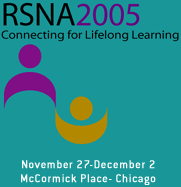
Abstract Archives of the RSNA, 2005
Fuhua Yan MD, PhD, Abstract Co-Author: Nothing to Disclose
Pengju Xu MD, Abstract Co-Author: Nothing to Disclose
Guo-Qing Wei PhD, Abstract Co-Author: Nothing to Disclose
Xiaolan Zeng PHD, Presenter: Nothing to Disclose
Li Fan PhD, Abstract Co-Author: Nothing to Disclose
Jian-Zhong Qian PhD, Abstract Co-Author: Nothing to Disclose
To evaluate the feasibility of computer assistance for the diagnosis of liver lesions, esp. small HCCs(<30mm) from dynamic contrast MDCT scans, by employing tools of automated quantification of attenuation and enhancement patterns that are enabled by automatic lesion registration.
52 tri-phase MDCT studies were acquired at pre-contrast, arterial and portal venous phases (33 and 85 seconds after intravenous injection). The scans were evaluated for the diagnosis of liver lesion using a computer tool (EDDA Technology, Inc). The tool automatically computes corresponding locations of an identified lesion in the other two scans, and allows synchronized visualization of tri-phase images simultaneously. The lesion’s attenuation pattern is automatically quantified and plotted with respect to normal liver parenchyma.
Out of the 93 lesions identified (7-29mm, mean at 19.5mm) using the computer tool, 78 were diagnosed as small HCCs, 10 as hepatic cysts, and 5 as hemangiomas. In terms of the attenuation difference between lesions and parenchyma in the arterial phase, the computer-measured maximum attenuation differences were distinctively, for cyst: -27.9±6.2 HU, for HCC: +17±8.7 HU, for hemangioma: +39±8.1 HU. The enhancement pattern of HCCs with respect to normal liver parenchyma was further categorized, in terms of precontrast, arterial and portal venous phases. (49/75) 65.3% was quantified as having the “iso/hypo—hyper—hypo” attenuation pattern, (18/75) 24.0% as “iso/hypo—hypo—hypo” attenuation pattern, the rest (8/75) with atypical patterns. The contrast changes for all HCCs (irrespective of their enhancement patterns) from precontrast to arterial phases, and from arterial to portal venous phases were, +19.2±15.1 HU and -23.1±11.3 HU, respectively.
Automatic quantification of lesion attenuation suggests distinction among HCC, cyst and hemangioma. Quantification of enhancement patterns objectively reflected the contrast characteristics of small HCC lesions. The automatic registration and quantification tool may provide help for diagnosis and lead to improved consistency and accuracy.
Yan, F,
Xu, P,
Wei, G,
Zeng, X,
Fan, L,
Qian, J,
Computer-assisted Evaluation of Liver Lesions by Multiphase Dynamic Imaging Using MDCT. Radiological Society of North America 2005 Scientific Assembly and Annual Meeting, November 27 - December 2, 2005 ,Chicago IL.
http://archive.rsna.org/2005/4410964.html

